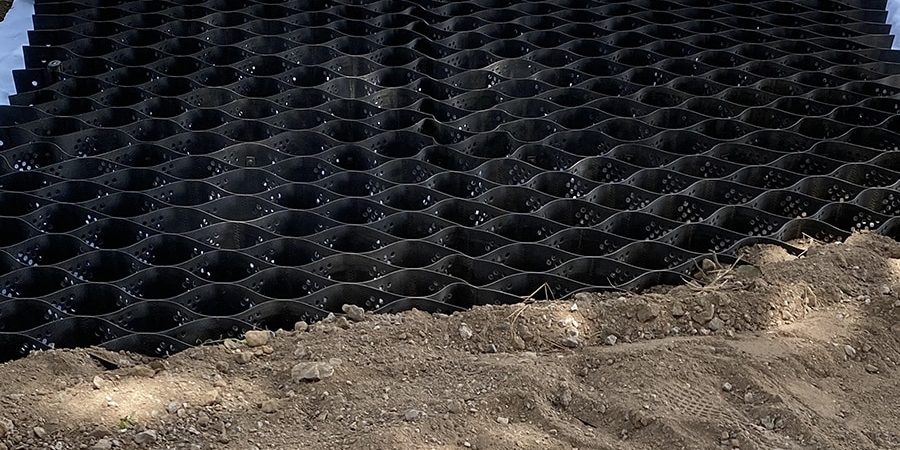Geocells are one of the most effective ways to create long-term stability for your construction and landscaping products. Whether you’re looking to increase tensile strength or control erosion, geocells offer a cost-effective solution.
Here’s everything you need to know from what are geocells to how they work.
What are Geocells?
Geocells use a three-dimensional honeycomb design to produce increased durability and stability. After installation, they are filled with aggregate materials. Usually, soil or gravel works effectively, but the fill material depends on the project.
What are Geocells Made of?
Geocells are made from high-density polyethylene (HDPE). This material is both lightweight and sustainable. It is also an extremely durable and long-lasting material.
The main source advantage of high-density polyethylene is its strength. HDPE has a tensile strength ranging from 20 to 40 MPa and can withstand substantial pulling or stretching forces.
How GeoCell Works
Geocells are designed to distribute loads over a larger area. The unique honeycomb shape of the cells works to increase structural strength while preventing soil erosion.
The infill materials are secured within the cell, preventing shifting or sinkage. The cells will reinforce these infill materials, reducing the chances of runoff or soil loss.
Geocells Advantages
The multipurpose functionality of geocells makes them an ideal solution for a wide range of projects. Some of the main advantages are:
Multipurpose: Geocells can be used for a number of projects. They can suit a variety of needs for each use, controlling soil movement while offering extra stability.
Cost Effective: Geocells can create the same load-bearing support with fewer materials, making it a cost-effective alternative.
Environmentally Friendly: Geocells are a permeable solution. They allow water to flow naturally through the ground and back into the water table.
Easy Installation: Geocell is exceptionally easy to install. You simply lay down the product and add in the fill materials.
What are Geocells Used For?
Geocells are used for a variety of projects, mostly for load support and erosion control. Some of the common uses for geocells are as follows:
Slope Control: Geocells prevent erosion or soil slippage, making them extremely effective in controlling and maintaining slopes.
Road Construction: The strength of geocells can be used to support cars and other vehicles.
Soil Stabilization: Geocells stabilize the surface level, preventing soil from sinking and shifting.
Load Distribution and Support: One of the main uses for geocells is to distribute weight across a larger and more stable area. This is ideal for creating strong load support.
Channel Protection: Geocells are permeable, which makes them adept at providing support in hydraulic environments.
Green Roofs and Walls: The ecological benefits of geocells make them a great option for creating green spaces. Green roofs and walls require soil stabilization and structural stability that geocell can provide.
Retaining Walls: Geocells also work particularly well at creating slope control for retaining walls. They are excellent at controlling potential stability problems.
Examples of some common projects that could benefit from geocells are:
- Sheds
- Carports
- Playsets
- Driveways
- Horse Arenas and Stalls
- Parking Areas
- Gazebos
- Hot Tubs
- Walkways
- Landscaping
Types of Geocells
Geocell Sizes
There are several different types of geocells. The right type for your project is usually determined by the product’s size.
Larger sizes are needed for higher-strength projects, steep slopes, and other more substantial projects. Smaller-sized geocells are effective for smaller projects that require less load support.
BaseCore™ Geocells are offered in multiple strengths and sizes. With HD options you can add additional load-bearing capacity and strength with fewer materials. Consult one of our experts to determine which type is ideal for your project.
- 2″ BaseCore HD™
- 3″ BaseCore HD™
- 3″ BaseCore™
Perforated vs Non-Perforated Geocells
Outside of the different sizing options available, there are also different types of geocells. The main two options are perforated and non-perforated.
Perforated geocells have small holes in the sides of each cell to allow for better water flow. These types of cells are more stable and permeable. They are eco-friendly and tend to be stronger than non-perforated versions.
Non-perforated geocells are applicable when you are looking to control water leakage. For projects where you want to prevent water from passing through, non-perforated geocells are a good option.
Consult a Geocell Expert
Using geocells effectively means finding the right type and size for your project. This will depend on what you are looking to use the product for.
A walking path will need a smaller cell size than a 6:1 slope. A landscaping project might need a perforated geocell whereas a channel construction project will require a non-perforated geocell.
To ensure that you are choosing the correct cell, consult a geocell expert.
Give Us a Call
Still unsure what are geocells and how geocells can improve your project? Looking for advice on what type of geocell will be most effective? We have experts on hand ready to help. Give us a call at 888-897-2224 to learn more.
